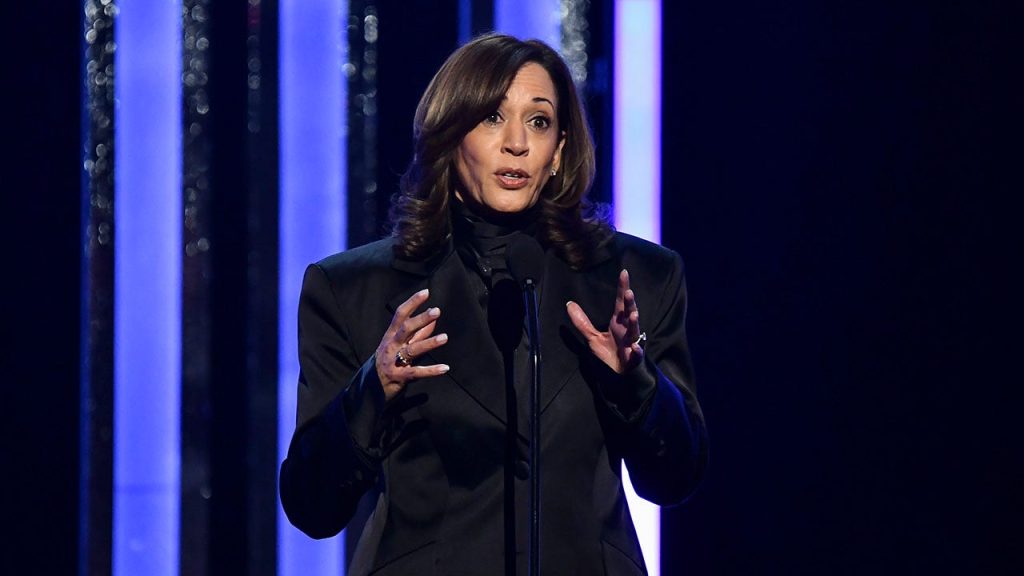Former Vice President Kamala Harris delivered a significant speech during the 56th NAACP Image Awards in Pasadena, California, marking her first public address since her loss in the November presidential election. Accepting the NAACP’s Chairman’s Award, she called for a “sense of urgency” among the audience, urging active participation in safeguarding democracy. By invoking themes of faith, unity, and resilience, Harris aimed to inspire collective action against rising challenges that threaten American values.
| Article Subheadings |
|---|
| 1) Harris’s Return to the Public Eye |
| 2) Call for Active Participation |
| 3) Addressing Historical Challenges |
| 4) The Democratic Party’s Current Dilemma |
| 5) Future Strategies for Harris |
Harris’s Return to the Public Eye
The speech by Kamala Harris came after a notable absence from the public spotlight, reflecting on her recent defeat in the presidential election. Her re-emergence at such a prominent event suggests a strategic reclamation of her voice within the Democratic Party’s landscape. By choosing to speak at the NAACP Image Awards, she not only recognized the importance of civil rights but also aligned herself with an organization that has been pivotal in advocating for equality and justice throughout American history. The award she accepted is indicative of her contributions in promoting these values during her career.
Call for Active Participation
During her acceptance speech, Harris emphasized the importance of urgency and proactive involvement in the fight for America’s democratic ideals. She proclaimed, “eternal vigilance is the price of liberty,” calling on the audience to remain alert and engaged. This appeal is significant as it reflects not merely a plea for attention but a rallying cry for individuals and communities to unite against the threats that compromise their freedoms. Harris’s insistence on mobilization and advocacy aligns with broader calls from political leaders for grassroots efforts to foster societal resilience.
Addressing Historical Challenges
In her speech, Harris drew on historical contexts, reminding the audience of the organization’s origins during times of extreme societal division. She articulated a sense of collective responsibility: “Our power has never come from having an easy path.” This statement frames her message within the struggles faced by previous generations of activists who fought against systemic oppression. By recalling the historical weight of civil rights battles, Harris aimed to inspire a new generation to recognize the importance of their contributions in shaping America’s narrative.
The Democratic Party’s Current Dilemma
Harris’s remarks are particularly poignant given the current state of the Democratic Party, which is navigating a crisis of identity and messaging following the recent electoral defeat. With the shadow of Donald Trump‘s presidency looming, party leaders are tasked with regaining ground among disillusioned voters. Harris’s speech provides insight into how she perceives her role moving forward—a leader who continues to advocate for Democratic values and collective well-being. The implications of her relationship with grassroots movements may inform the party’s strategy to invigorate its base.
Future Strategies for Harris
In light of her ongoing career, Harris has recently allied herself with the Creative Artists Agency, which indicates her ambition to maintain a public presence that transcends traditional political channels. This partnership is envisioned to expand her platform and amplify her advocacy work. As she prepares for a future that may include more public speaking engagements and writing initiatives, Harris aims to cement her influence in both political and cultural spheres.
| No. | Key Points |
|---|---|
| 1 | Harris returned to public engagements by addressing the NAACP Image Awards. |
| 2 | She called for a ‘sense of urgency’ in protecting democratic values. |
| 3 | A historical context was provided, signifying past struggles for civil rights. |
| 4 | The Democratic Party is currently in a period of self-reflection and strategy reassessment. |
| 5 | Harris is aligning with influential agencies to broaden her influence post-vice presidency. |
Summary
Kamala Harris’s speech at the NAACP Image Awards underscores her commitment to civil rights and her intent to remain a significant figure in the political landscape following her electoral defeat. By framing her message around historical struggles and aiming to mobilize grassroots efforts, she calls upon citizens to engage actively in the fight for democracy. As she navigates the future, Harris’s strategies to expand her voice through new partnerships will be essential in redefining her role in a dynamic political era.
Frequently Asked Questions
Question: What was the significance of Harris’s speech at the NAACP Image Awards?
Harris’s speech was significant as it marked her return to public life after her electoral defeat, emphasizing the importance of civil rights and urging collective action among citizens to protect democracy.
Question: How does Harris view her role in the future of the Democratic Party?
Harris sees herself as a leader who continues to advocate for Democratic values while also addressing the party’s need for revitalization and grassroots engagement.
Question: What initiatives might Harris pursue after her vice presidency?
Post-vice presidency, Harris plans to engage in public speaking and writing initiatives, focusing on advocacy and community organizing, which she aims to enhance through her partnership with the Creative Artists Agency.


